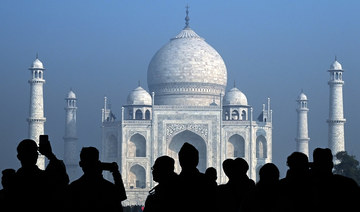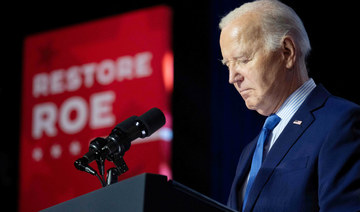AUSTIN, Texas: The cancer charity whose yellow wristbands became a global brand under founder Lance Armstrong is seeking to reinvent itself, years after donations and revenues crashed along with the disgraced cyclist’s career.
Armstrong was nowhere to be seen earlier this month during Livestrong’s “relaunch” ceremony in Austin. The charity announced plans to end its one-on-one cancer support services, where a patient could call for help dealing with insurance, counseling and medical trials. Instead, it will pivot to spending $5-6 million annually to support entrepreneurs developing products to improve treatment and patient care.
Livestrong will maintain its partnership with the Livestrong Cancer Institutes at the University of Texas Dell Medical School, which focuses on cancer research, patient care and treatment.
“We’re more than a wristband,” Livestrong President and CEO Greg Lee told a crowd of about 200 gathered for the event. A few minutes earlier, Gloria Gaynor’s 1970s hit single “I Will Survive” pumped out of the speakers.
Livestrong’s trademark yellow wristbands were once worn by celebrities and politicians the world over. Donations and commercial ties to athletic apparel company Nike brought in tens of millions annually.
But those days are gone. The wristbands are rarely seen anymore, and Nike ended its Livestrong clothing line years ago.
The legacy and reputation of Armstrong, a cancer survivor who won the Tour de France seven times, crumbled abruptly following revelations he used performance-enhancing drugs. Livestrong has chugged along as a much smaller, leaner organization.
The relaunch came with an artistic redesign. Gone is the yellow-and-black “Livestrong” logo that mimicked the wristband, which is still available for purchase online. The logo has been replaced by a blue background with three rings — orange, blue and yellow.
“We’re nimble,” Lee said. “We’re not like an ocean liner. We’re more like a jet ski that can turn on a dime.”
Lee insists the move is about better serving cancer patients, not just reversing declining financial trends.
Livestrong was a pioneer in providing one-on-one help to guide people through difficult and sometimes traumatic cancer diagnosis and treatment. The model has been successfully copied by many. The company therefore needs to find new, unique ways to help patients, Lee said.
A money drain also needs attention.
Armstrong founded Lance Armstrong Foundation in 1997 after he was diagnosed with testicular cancer that had spread to his lungs and brain. His remarkable recovery and success on the world’s biggest stage for cyclists fueled a boom that transformed the once small charity into a global force.
At its peak, Livestrong took in $41 million in donations in 2009 when Armstrong came out of retirement to finish third in the Tour de France. The downturn came when Armstrong’s career and reputation were undone first by a 2012 investigation in performance-enhancing drug use and his 2013 confession in a televised interview with Oprah Winfrey.
The charity desperately tried to distance itself from the scandal. Armstrong was pushed out of his role as chairman of the board of directors — he remains listed as a board emeritus member but is otherwise not involved — and the foundation’s name was formally changed to Livestrong.
According to 2018 financial records, the most recent available, donations and revenue had dipped under $2.5 million. Assets listed at $100 million a decade ago have been whittled to $46 million. That includes a $37 million endowment, which has about $15 million tied to specific spending restrictions.
The 2018 report doesn’t reflect the $17 million sale in 2019 of Livestrong’s former headquarters in downtown Austin.
With that money in the bank, analysts at charity watchdog groups Charity Navigator and Charity Watch still give Livestrong good marks for being financially healthy overall and transparent in how it spends. And donations at least have leveled off from their initial plummet.
But Livestrong still spent three times what it takes in on it national partnership with the YMCA, the local one with the University of Texas, and operating expenses. Lee’s salary is about $350,000 a year.
“They are going to have to increase revenue or decrease spending. It will be a question of how they maintain that revenue,” said, Kevin Doyle analyst with Charity Navigator.
Lee said Livestrong will shift from it’s main fundraising model from one that depends on contributions at large to one that more aggressively seeks corporate and venture-capital partnerships to support its grants and gifts.
Grants could support a wide range of tools for helping cancer patients, such as transportation services or smart phone applications that help patients organize treatment records or connect with multiple physicians, Lee said
Livestrong still has a formidable brand that will likely attract interest from grant applicants and investors, said Daniel Borochoff, founder of Charity Watch.
“They are still a high-profile group,” Borochoff said. “People will be motivated to have the Livestrong name backing them.”
A decade ago, Armstrong’s towering presence alone could draw money as he dominated the world’s most famous bike race or flew around the world to meet with celebrities and political leaders at global cancer forums. Back in 2007, it was Armstrong’s late-hour lobbying that pushed Texas lawmakers to pass a $3 billion cancer research fund.
But his divorce from Livestrong was bitter. Armstrong’s name and image were completely scrubbed from the re-launch celebration.
There were no photographs of Armstrong used in a video compilation of cancer patients and celebratory moments. His presence was missing from a display charting the foundation’s first two decades, which included a large bowl filled with yellow Livestrong bracelets.
One speaker mentioned the foundation had been through good times and bad. Only the event host’s passing reference to a “famous founder” seemed to acknowledge his impact in starting it all.
A Livestrong spokeswoman said the charity offered to brief Armstrong ahead of the unveiling party, but he declined. Armstrong declined comment when contacted by The Associated Press.
“We have done everything we can to talk to tell people that (Livestrong) is not about one person,” Lee said. “We have a changing focus, a new mission and a new visual identity.”
Charity founded by disgraced cyclist Lance Armstrong announces relaunch plan
https://arab.news/2gnph
Charity founded by disgraced cyclist Lance Armstrong announces relaunch plan
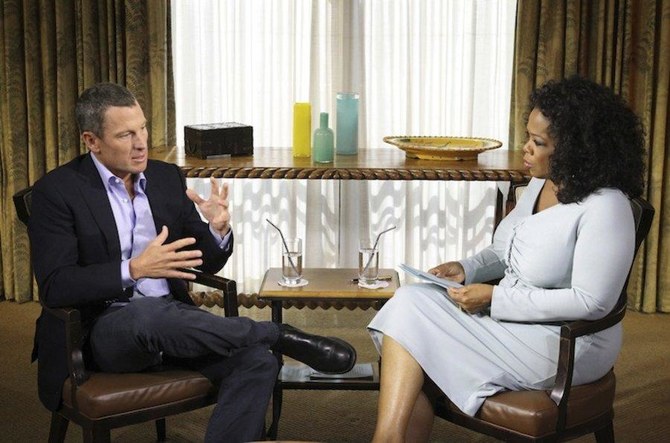
- Armstrong was nowhere to be seen earlier this month during Livestrong’s relaunch ceremony in Austin
- Livestrong’s trademark yellow wristbands were once worn by celebrities and politicians the world over
ASEAN says ‘deeply concerned’ over escalating Myanmar violence
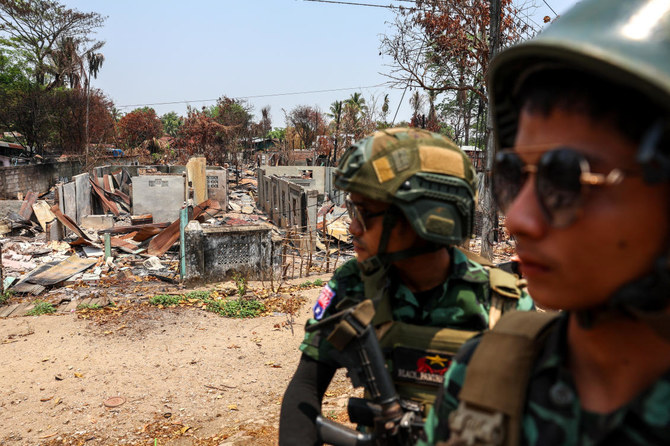
- ASEAN foreign ministers urge ‘all parties for an immediate cessation of violence’ in Myanmar
BANGKOK: Regional bloc ASEAN said it is “deeply concerned” about a recent upsurge in fighting in Myanmar, after fierce clashes over a key trading hub near the Thai border.
The foreign ministers of the Association of Southeast Asian Nations urged “all parties for an immediate cessation of violence” in Myanmar, which has been roiled by conflict since the military seized power in a February 2021 coup.
The ministers’ statement issued late Thursday said ASEAN was “deeply concerned over the recent escalation of conflicts, including in the area of Myawaddy.”
The military was last week forced to pull its troops out of positions in the valuable trading post after days of battling with the Karen National Union (KNU) — a long-established ethnic minority armed group — and other anti-junta fighters.
It was the latest blow suffered by the junta, which has suffered a string of battlefield losses in recent months, with some analysts warning it is its most significant threat to date.
Myawaddy is Myanmar’s main trade link to Thailand, and usually sees over a billion dollars worth of trade annually.
The clashes saw people flee across the border into Thailand — from where gunfire and the boom of artillery barrages could be heard.
Thailand has said it is ready to receive people from Myanmar, though the kingdom’s foreign minister warned it would not tolerate any violation of its sovereignty.
India starts voting in the world’s largest election as Modi seeks third term as PM
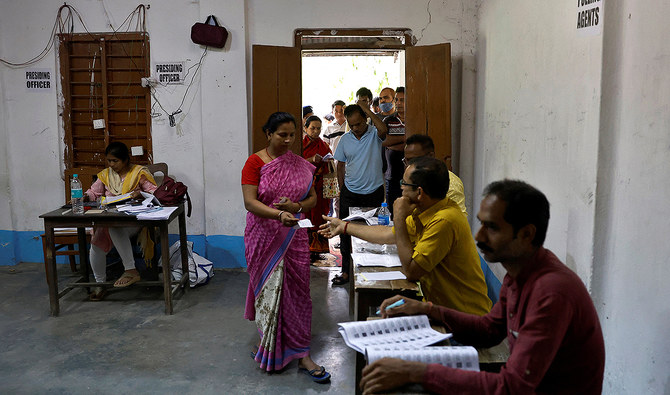
- Nearly 970 million voters will elect 543 members to lower house of Parliament
- The staggered elections will run until June 1, votes will be counted on June 4
NEW DELHI: Millions of Indians began voting Friday in a six-week election that’s a referendum on Narendra Modi, the populist prime minister who has championed an assertive brand of Hindu nationalist politics and is seeking a rare third term as the country’s leader.
The voters began queuing up at polling stations hours before they were allowed in at 7 a.m. in the first 21 states to hold votes, from the Himalayan mountains to the tropical Andaman Islands. Nearly 970 million voters — more than 10 percent of the world’s population — will elect 543 members to the lower house of Parliament for five years during the staggered elections that run until June 1. The votes will be counted on June 4.
One voter said she came early to avoid the summer heat later in the day.
Prime Minister Modi urged people to vote in record numbers. “I particularly call upon the young and first-time voters to vote in large numbers. After all, every vote counts and every voice matters!” he said in a message on the social media platform X.
This election is seen as one of the most consequential in India’s history and will test the limits of Modi’s political dominance.
If Modi wins, he’ll be only the second Indian leader to retain power for a third term, after Jawaharlal Nehru, the country’s first prime minister.
Most polls predict a win for Modi and his Hindu nationalist Bharatiya Janata Party, who are up against a broad opposition alliance led by the Indian National Congress and powerful regional parties.
It’s not clear who will lead India if the opposition alliance, called INDIA, wins the election. Its more than 20 parties have not put forward a candidate, saying they will choose one after the results are known.
The BJP is facing the toughest challenge in southern Tamil Nadu state with 39 seats where the voting is being held on Friday. The BJP drew a blank in 2019 and won one seat in the 2014 elections with the region dominated by two powerful regional groups, Dravida Munnetra Kazhagam and All India Anna Dravida Munnetra Kazhagam.
Modi focussed on the state this time and visited it more than a dozen times, holding several rallies and roadshows.
P. Chidambaram, an opposition Congress party leader and the country’s former finance minister, said after voting in Tamil Nadu state that people would not vote for the BJP in the state as “It is imposing one language, one culture, one system and one kind of food.”
The voting also is taking place in the northeastern state of Manipur that was ravaged by a near-civil war for a year caused by fighting between the majority Meitei and tribal Kuki-Zo people. Mobs have rampaged through villages and torched houses.
The election authority has set up voting stations for nearly 320 relief camps where more than 59,000 men, women and children are living. The state stands divided between a valley controlled by the Meiteis and the Kuki-dominated hills.
More than 150 people were killed and over 60,000 displaced. The voting for two seats will be completed on April 26.
In the 2019 elections, the BJP and its allies had won 39 of 102 seats where the voting is taking place on Friday. These include Rajasthan, Uttarakhand and West Bengal states.
The election comes after a decade of Modi’s leadership, during which the BJP has consolidated power through a combination of Hindu-first politics and economic development.
Modi has ratcheted up Hindu nationalist rhetoric on the campaign trail, and has sought to present himself as a global leader. His ministers tout him as the steward of a surging India, while his supporters celebrate his campaign promise to make India a developed nation by 2047, when it marks 100 years of independence.
But while India’s economy is among the world’s fastest-growing, many of its people face growing economic distress. The opposition alliance is hoping to tap into this, seeking to galvanize voters on issues like high unemployment, inflation, corruption and low agricultural prices that have driven two years of farmers’ protests.
Critics warn that Modi has turned increasingly illiberal and that he could use a third term to undermine India’s democracy. His Hindu nationalist politics, they argue, has bred intolerance and threatens the country’s secular roots.
The alliance has promised to arrest the democratic slide it says India has witnessed under Modi’s rule. They accuse Modi of sidelining elected ministers in favor of trusted bureaucrats and using tax authorities and the police to harass critics and opposition parties.
“Modi has a very authoritarian mindset. He doesn’t believe in democracy. He doesn’t believe in Parliamentarianism,” said Christophe Jaffrelot, who has written about Modi and the Hindu right.
Modi insists that India’s commitment to democracy is unchanged. He told a Summit for Democracy meeting in New Delhi in March that ‘“India is not only fulfilling the aspirations of its 1.4 billion people, but is also providing hope to the world that democracy delivers and empowers.’’
The Indian leader enjoys vast popularity among India’s 1.4 billion people. His BJP dominates in Hindi-speaking northern and central parts of India, and is now trying to gain a foothold in the east and south to capture a two-thirds majority. Modi and other BJP candidates have repeatedly vowed to take at least 400 seats.
The party hopes for a landslide win powered by its popular welfare programs, which it says have improved access to clean toilets, health care and cooking gas, as well as providing free grain to the poor. Moves like the construction of a controversial temple to Ram on the site of a demolished mosque, and the scrapping of the disputed Muslim-majority region of Kashmir’s former autonomy, may resonate with supporters who hail him as the champion of the Hindu majority.
“Any party that comes back for a third term, and with a brute majority, is a scary prospect for democracy,” said Arati Jerath, a political commentator.
Modi’s two terms have seen civil liberties in India come under attack and it implementing what critics say are discriminatory policies. Peaceful protests have been crushed with force. A once free and diverse press is threatened, violence is on the rise against the Muslim minority, and government agencies have arrested opposition politicians in alleged corruption cases.
The BJP has denied its policies are discriminatory and says its work benefits all Indians.
Once a fringe Indian ideology, Hindu nationalism is now mainstream, thanks to Modi’s decade in power
Once a fringe Indian ideology, Hindu nationalism is now mainstream, thanks to Modi’s decade in power
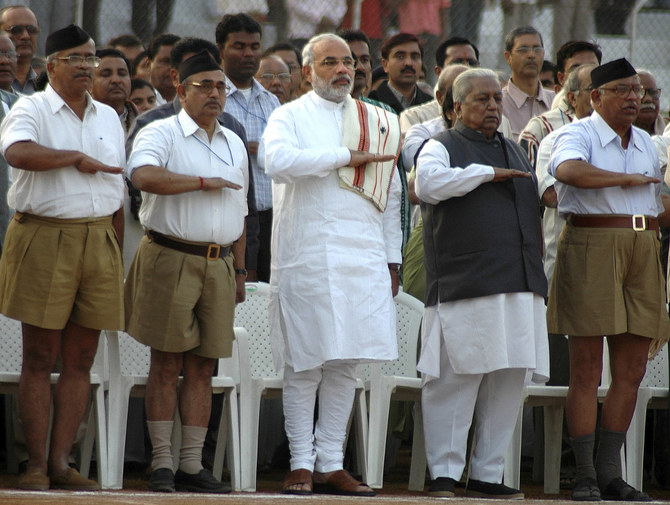
- While Mahatma Gandhi preached Hindu-Muslim unity a few decades earlier, the RSS advocated for transforming India into a Hindu nation
- RSS, which stands for Rashtriya Swayamsevak Sangh, is paramilitary, right-wing group founded nearly a century ago
- Modi joined the political wing of the RSS in the late 1960s in their home state, Gujarat, when he was a teenager
AHMEDABAD, India: Hindu nationalism, once a fringe ideology in India, is now mainstream. Nobody has done more to advance this cause than Prime Minister Narendra Modi, one of India’s most beloved and polarizing political leaders.
And no entity has had more influence on his political philosophy and ambitions than a paramilitary, right-wing group founded nearly a century ago and known as the RSS.
“We never imagined that we would get power in such a way,” said Ambalal Koshti, 76, who says he first brought Modi into the political wing of the Rashtriya Swayamsevak Sangh in the late 1960s in their home state, Gujarat.
Modi was a teenager. Like other young men — and even boys — who joined, he would learn to march in formation, fight, meditate and protect their Hindu homeland.
A few decades earlier, while Mahatma Gandhi preached Hindu-Muslim unity, the RSS advocated for transforming India — by force, if necessary — into a Hindu nation. (A former RSS worker would fire three bullets into Gandhi’s chest in 1948, killing him months after India gained independence.)
Modi’s spiritual and political upbringing from the RSS is the driving force, experts say, in everything he’s done as prime minister over the past 10 years, a period that has seen India become a global power and the world’s fifth-largest economy.
At the same time, his rule has seen brazen attacks against minorities — particularly Muslims — from hate speech to lynchings. India’s democracy, critics say, is faltering as the press, political opponents and courts face growing threats. And Modi has increasingly blurred the line between religion and state.
At 73, Modi is campaigning for a third term in a general election, which starts Friday. He and the ruling Bharatiya Janata Party are expected to win. He’s challenged by a broad but divided alliance of regional parties.
Supporters and critics agree on one thing: Modi has achieved staying power by making Hindu nationalism acceptable — desirable, even — to a nation of 1.4 billion that for decades prided itself on pluralism and secularism. With that comes an immense vote bank: 80 percent of Indians are Hindu.
“He is 100 percent an ideological product of the RSS,“in said Nilanjan Mukhopadhyay, who wrote a Modi biography. “He has delivered their goals.”
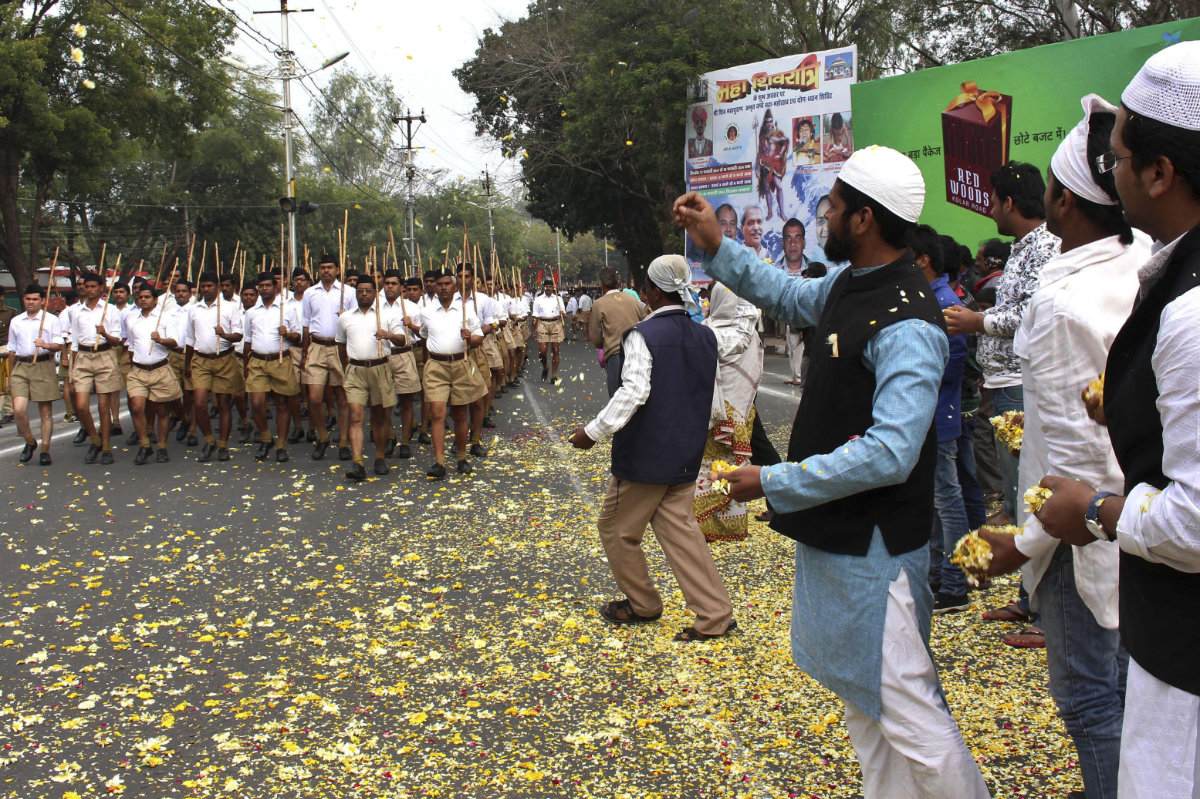
Uniting Hindus
Between deep breaths under the night sky in western India a few weeks ago, a group of boys recited an RSS prayer in Sanskrit: “All Hindus are the children of Mother India ... we have taken a vow to be equals and a promise to save our religion.”
More than 65 years ago, Modi was one of them. Born in 1950 to a lower-caste family, his first exposure to the RSS was through shakhas — local units — that induct boys by combining religious education with self-defense skills and games.
By the 1970s, Modi was a full-time campaigner, canvassing neighborhoods on bicycle to raise RSS support.
“At that time, Hindus were scared to come together,” Koshti said. “We were trying to unite them.”
The RSS — formed in 1925, with the stated intent to strengthen the Hindu community — was hardly mainstream. It was tainted by links to Gandhi’s assassination and accused of stoking hatred against Muslims as periodic riots roiled India.
For the group, Indian civilization is inseparable from Hinduism, while critics say its philosophy is rooted in Hindu supremacy.
Today, the RSS has spawned a network of affiliated groups, from student and farmer unions to nonprofits and vigilante organizations often accused of violence. Their power — and legitimacy — ultimately comes from the BJP, which emerged from the RSS.
“Until Modi, the BJP had never won a majority on their own in India’s Parliament,” said Christophe Jaffrelot, an expert on Modi and the Hindu right. “For the RSS, it is unprecedented.”
Scaling his politics
Modi got his first big political break in 2001, becoming chief minister of home state Gujarat. A few months in, anti-Muslim riots ripped through the region, killing at least 1,000 people.
There were suspicions that Modi quietly supported the riots, but he denied the allegations and India’s top court absolved him over lack of evidence.
Instead of crushing his political career, the riots boosted it.
Modi doubled down on Hindu nationalism, Jaffrelot said, capitalizing on religious tensions for political gain. Gujarat’s reputation suffered from the riots, so he turned to big businesses to build factories, create jobs and spur development.
“This created a political economy — he built close relations with capitalists who in turn backed him,” Jaffrelot said.
Modi became increasingly authoritarian, Jaffrelot described, consolidating power over police and courts and bypassing the media to connect directly with voters.
The “Gujarat Model,” as Modi coined it, portended what he would do as a prime minister.
“He gave Hindu nationalism a populist flavor,” Jaffrelot said. “Modi invented it in Gujarat, and today he has scaled it across the country.”
A few decades earlier,
In June, Modi aims not just to win a third time — he’s set a target of receiving two-thirds of the vote. And he’s touted big plans.
“I’m working every moment to make India a developed nation by 2047,” Modi said at a rally. He also wants to abolish poverty and make the economy the world’s third-largest.
If Modi wins, he’ll be the second Indian leader, after Jawaharlal Nehru, to retain power for a third term.
With approval ratings over 70 percent, Modi’s popularity has eclipsed that of his party. Supporters see him as a strongman leader, unafraid to take on India’s enemies, from Pakistan to the liberal elite. He’s backed by the rich, whose wealth has surged under him. For the poor, a slew of free programs, from food to housing, deflect the pain of high unemployment and inflation. Western leaders and companies line up to court him, turning to India as a counterweight against China.
He’s meticulously built his reputation. In a nod to his Hinduism, he practices yoga in front of TV crews and the UN, extols the virtues of a vegetarian diet, and preaches about reclaiming India’s glory. He refers to himself in the third person.
P.K. Laheri, a former senior bureaucrat in Gujarat, said Modi “does not risk anything” when it comes to winning — he goes into the election thinking the party won’t miss a single seat.
The common thread of Modi’s rise, analysts say, is that his most consequential policies are ambitions of the RSS.
In 2019, his government revoked the special status of disputed Kashmir, the country’s only Muslim-majority region. His government passed a citizenship law excluding Muslim migrants. In January, Modi delivered on a longstanding demand from the RSS — and millions of Hindus — when he opened a temple on the site of a razed mosque.
The BJP has denied enacting discriminatory policies and says its work benefits all Indians.
Last week, the BJP said it would pass a common legal code for all Indians — another RSS desire — to replace religious personal laws. Muslim leaders and others oppose it.
But Modi’s politics are appealing to those well beyond right-wing nationalists — the issues have resonated deeply with regular Hindus. Unlike those before him, Modi paints a picture of a rising India as a Hindu one.
Satish Ahlani, a school principal, said he’ll vote for Modi. Today, Ahlani said, Gujarat is thriving — as is India.
“Wherever our name hadn’t reached, it is now there,” he said. “Being Hindu is our identity; that is why we want a Hindu country. ... For the progress of the country, Muslims will have to be with us. They should accept this and come along.”
Legislation that could force a TikTok ban revived as part of House foreign aid package
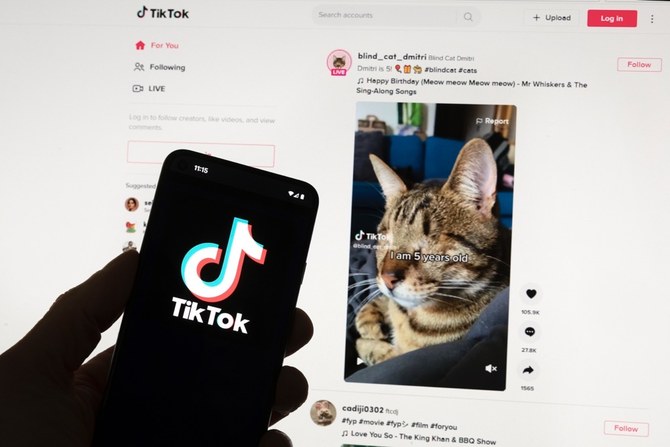
WASHINGTON: Legislation that could ban TikTok in the US if its China-based owner doesn’t sell its stake won a major boost late Wednesday when House Republican leaders included it in a package of bills that would send aid to Ukraine and Israel. The bill could be law as soon as next week if Congress moves quickly.
The TikTok legislation, which passed the House in March and has widespread support in both chambers, was included in the House package as leaders have worked to win votes for the foreign aid bills and after negotiations with the Senate over how long the Chinese technology firm ByteDance Ltd. would have to sell its stake in the app to continue operating in the United States. President Joe Biden has said he would sign the TikTok legislation if it reaches his desk.
The new version of the legislation won a key endorsement from Senate Commerce Committee Chairwoman Maria Cantwell, who said in a statement that she had successfully pushed to extend the period from six months to a year to give the company enough time to find a buyer. While the original bill had a six-month deadline for TikTok to be sold, the revised legislation would give nine months and a possible three-month extension if a sale was in progress.
“Extending the divestment period is necessary to ensure there is enough time for a new buyer to get a deal done,” said Cantwell, who had previously expressed doubts about the bill. ”I support this updated legislation.”
If Congress passes the TikTok bill, it would be an extraordinary and unusual moment in which both parties unite against one company – something lawmakers are usually reluctant to do. But the popular social media app has prompted widespread outrage on Capitol Hill, where there is bipartisan concern about Chinese threats to the United States and where few members use the platform themselves.
Opponents say they believe the ban would be unconstitutional, and there would be likely court challenges if it passes. There has been aggressive pushback from the company, content creators who make money on the app and some of the platform’s 170 million US users, many of whom are young. In some cases, lawmakers have received profanity-laced calls from users who were prompted by the app to call their representatives in Congress.
To date, the US government has not provided evidence that shows TikTok shared US user data with the Chinese government, or that Chinese authorities have tinkered with the company’s popular algorithm, which influences what Americans see.
Since mid-March, TikTok has spent $5 million on TV ads opposing the legislation, according to AdImpact, an advertising tracking firm. The ads have included a range of content creators, including a nun, extolling the positive impacts of the platform on their lives and arguing a ban would trample on the First Amendment.
TikTok has also spent money on Facebook and Instagram ads that, among other things, talk about investments in data safety. In addition, the company has mounted a lobbying campaign in Washington that included flying in content creators who rely on the platform for income.
Alex Haurek, a spokesman for the company, said in a statement Thursday that “It is unfortunate that the House of Representatives is using the cover of important foreign and humanitarian assistance to once again jam through a ban bill that would trample the free speech rights of 170 million Americans, devastate 7 million businesses, and shutter a platform that contributes $24 billion to the US economy, annually.”
Nadya Okamoto, a content creator who has roughly four million followers on TikTok, said she’s been having conversations with other creators who are experiencing “so much anger and anxiety” about the bill and how it’s going to impact their lives. The 26-year-old, whose company “August” sells menstrual products and is known for her advocacy around destigmatizing menstrual periods, makes most of her income from TikTok.
“This is going to have real repercussions,” she said.
Dan Ives, a tech analyst at the financial advisory firm Wedbush Securities, said such a sale would be very complex to carry out, even with an extended timeline.
The platform would come with a hefty price tag that only the biggest tech companies could afford, something that’s likely to raise antitrust concerns. Then, there’s the issue of TikTok’s algorithm, the app’s secret sauce that recommends videos to users. The bill bars ByteDance from controlling TikTok’s algorithm, and a potential sale is likely to face opposition from China, which has been clamping down on exports of recommendation algorithms by Chinese tech companies.
“Buying TikTok without the algorithm would be like buying a Ferrari without the engine,” said Ives.
Some investors, including former Treasury Secretary Steven Mnuchin and “Shark Tank” star Kevin O’Leary, have already voiced interest in buying TikTok’s US business. If a sale isn’t approved and the platform does get banned, Ives said it would be a “dream scenario” for Snapchat, Meta and YouTube, which have faced stiff competition from TikTok the past few years.
If the bill does pass, it would be the most significant step Congress has taken in decades to regulate the tech industry. For years Congress has failed to act on legislation that would protect users’ privacy, protect children online, make companies more liable for their content and put loose guardrails around artificial intelligence, among other things.
Still, it is a narrow shot at one company when many lawmakers would like to see broader change.
Democratic Sen. Mark Warner of Virginia, the chairman of the Senate Intelligence Committee, has been pushing for years for tech regulation. If the TikTok bill passes, he said, “it will be the first guardrail we put on anything on social media.”
Warner said there are a lot of other things that Congress needs to do, “but you’ve got to start someplace.”
While most lawmakers support the TikTok bill, some have said it would set a dangerous precedent.
“The passage of the House TikTok ban is not just a misguided overreach; it’s a draconian measure that stifles free expression, tramples constitutional rights, and disrupts the economic pursuits of millions of Americans,” Kentucky Sen. Rand Paul posted on X after the House passed it.
Others are defending the app’s loyal users.
“I am a NO on the TikTok bill we are about to vote on,” Florida Rep. Maxwell Frost posted on X before the House vote. At 27, Frost is much younger than most of his colleagues.
“I believe the bill does set TikTok up to be banned,” Frost said. “There are first amendment issues I see with taking away a platform that over 170 million Americans use, and this won’t fix the serious issues we have with data privacy.”
Jenna Leventoff, a lawyer for the American Civil Liberties Union, previewed potential First Amendment challenges to the bill.
“Congress cannot take away the rights of over 170 million Americans who use TikTok to express themselves, engage in political advocacy, and access information from around the world,” she said.
Over 100 pro-Palestinian protesters arrested from New York’s Columbia campus
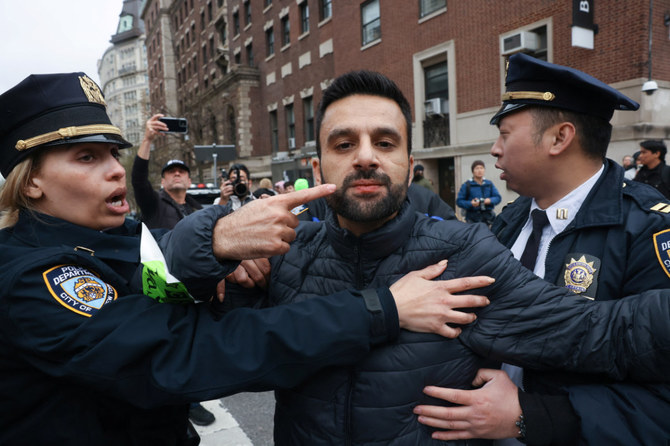
- University President Nemat Minouche Shafik said she authorized police to remove tents set up by protesters for the safety of the campus
- Protesters clashed with police, bringing back memories of the demonstrations against the Vietnam War at Columbia more than 50 years ago
More than 100 pro-Palestinian protesters were arrested on Wednesday on the campus of Columbia University after its president authorized New York police to clear an encampment set up by students demonstrating against Israel’s actions in Gaza.
Columbia University President Nemat Minouche Shafik, who a day earlier came under fire from Republicans at a House of Representatives committee hearing on antisemitism on campus, said she had authorized police to clear an encampment of dozens of tents set up by protesters on Wednesday morning.
“Out of an abundance of concern for the safety of Columbia’s campus, I authorized the New York Police Department to begin clearing the encampment ... ” Shafik said in a statement.
Shafik said the protesters had violated the school’s rules and policies against holding unauthorized demonstrations, and were not willing to engage with administrators.
New York City Mayor Eric Adams said police made over 108 arrests, adding “there was no violence or injuries during the disturbance.” Adams added students had the right to free speech but not the right to violate university policies. Police officials said the arrests were related to trespassing.
Columbia said it had started to suspend students who had participated in the tent encampment, which the school considers an unauthorized protest.
“We are continuing to identify them and will be sending out formal notifications,” a spokesperson of the university said in an email.
At least three students have already received suspension notices from Barnard College, an affiliate of Columbia, for participating in the encampment, Institute for Middle East Understanding, a pro-Palestinian advocacy group, said.
The three students were Isra Hirsi, Maryam Iqbal, and Soph Dinu, the institute said. Hirsi is the daughter of US Representative Ilhan Omar, who had expressed support for protesters during the hearing at which Shafik testified on Wednesday.
“Those of us in Gaza solidarity encampment will not be intimidated,” Hirsi said on social media after being suspended.
The clash, reminiscent of the demonstrations against the Vietnam War at Columbia more than 50 years ago, is the latest in a series of demonstrations on US university campuses since the latest escalation of the Israeli-Palestinian conflict began on Oct. 7. Anti-war protests have been staged near airports and on bridges in New York, Los Angeles and other cities, while vigils and marches have taken place in Washington and elsewhere.
Alongside the proliferations of protests, human rights advocates have also pointed to a rise in bias and hate against Jews, Arabs and Muslims in recent months.
The congressional committee on Wednesday accused Shafik of failing to protect Jewish students on campus, echoing accusations leveled against three other elite university leaders at a hearing last year that sent shockwaves through higher education.
She responded by saying the university was facing a “moral crisis” with antisemitism on campus, and Columbia had taken strong actions against suspected perpetrators.
Protesters at Columbia have demanded a permanent ceasefire in the Gaza enclave and an end to US military assistance for Israel, as well as divestment by the university from companies that profit from Israel’s incursion into Gaza.
The encampment was organized by a student-led coalition of groups, including Columbia University Apartheid Divest, Students for Justice in Palestine, and Jewish Voice for Peace.
Separately on Thursday, a march was also planned at the University of Southern California in support of Asna Tabassum, a Muslim student whose valedictorian speech was canceled by the university, which cited safety concerns.
Tabassum and her supporters say the university sought to silence her because of her opposition to the Israeli assault on Gaza, which has killed over 33,000 people, according to the Gazan health ministry, and displaced nearly all its 2.3 million population.
Israel’s assault was triggered by the Oct. 7 cross-border attack by Hamas militants that killed 1,200 people, according to Israeli tallies.








